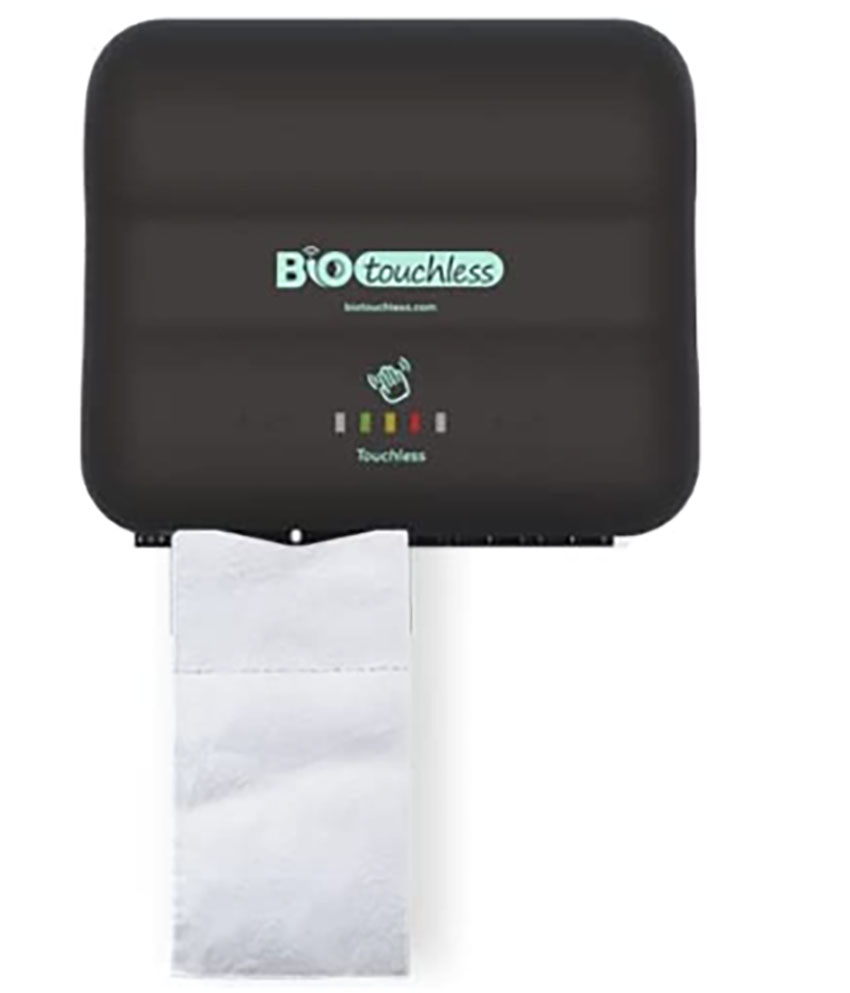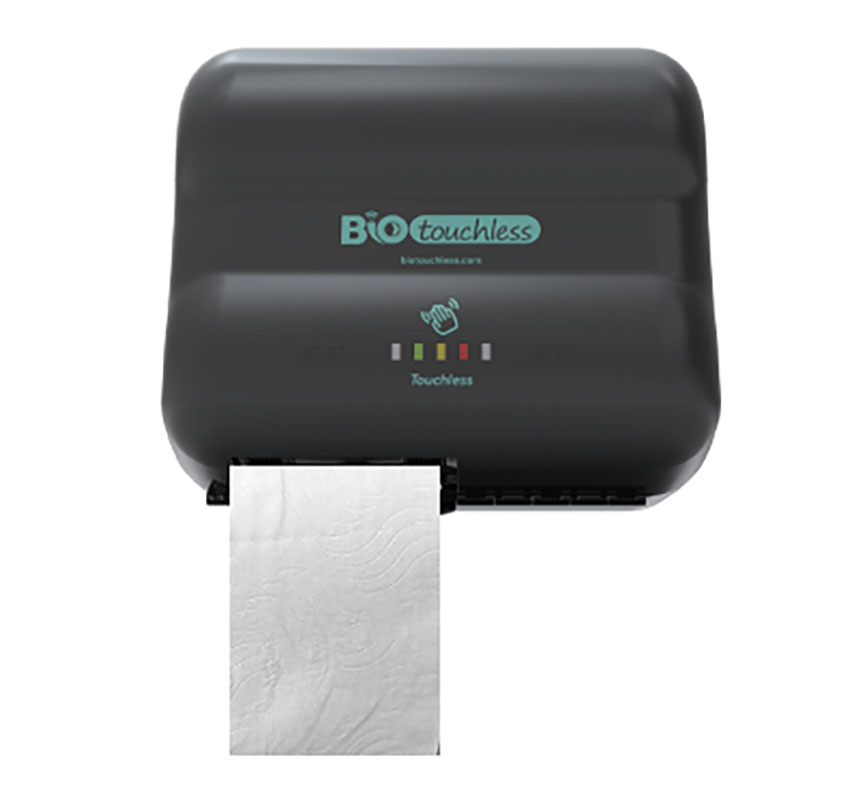BIOtouchless Is Reducing Toilet Paper Waste By 50% By Using Intelligent Technology. That technology is embedded in our touchless dispensers that meter the dispenses to stop waste.
Each person uses 100 rolls per year of toilet paper. That amounts to 384 trees for EVERY person in their lifetime. Today we produce 83 million rolls per day to serve this need in the United States. That makes it a minimum $10B problem. Change has to start somewhere.
Easy Engineering: Which are your best-selling products / solutions?
BIOtouchless: We have recently launched its initial product offering. The model number is the TP-100 and it is a fully enclosed, battery-operated, intelligent toilet paper dispensing system. It is the first of its kind in the world and as of today, there remains no competition for our product. We began shipping in October of 2022 and we are happy to say that all of our installations are operating without issue. It’s always a nervous time when you launch the first version of your production units into the field because you simply cannot test for every variable that can impact the operation of your product in the field. We are very fortunate that our product has experienced no issues and no engineering design modifications are called for. We know that’s not always the case! But so far, so good.
E.E: Why do users choose your products / solutions?
BIOtouchless: Our customers are tending to be equal parts cost conscience and environmentally conscience in the same decision maker. Some have started with the thought that cutting toilet paper waste by 50% would be a sufficient reason to acquire a new technology product. But when they find out that they’re actually going to be reducing their recurring toilet paper expenses by a full 50% year over year the decision becomes a little less idealistic and more fiscally responsible.

Conversely, the cost-cutting customers are always happy to hear that they are improving the sustainability rating of their organization because they are always being questioned about what they are doing to improve that rating by upper management.
At some point you have to realize that you can only change so many light bulbs to LED technology before you have to move into other areas to make this class of improvement.
E.E: What special features do your products / solutions have?
BIOtouchless: Our product offers a multitude of features that results in a turnkey device that simultaneously cuts waste and costs. we have made the old dumb toilet paper dispenser that had no governors on it which led to substantial waste an intelligent device by adding a printed circuit board and software that controls the operation of two motors that orchestrated the dispensing of paper reliably. One might think then it would be easy to do this reliably. But what we found out during our engineering development is that there are at least 10 different ways to tear toilet paper from a roll and that each one of those methods can lead to different challenges in terms of reliability.
As an example, if a person pulls vertically down on the paper very hard and suddenly it could cause a tear in the perforation above the rollers. That would mean paper would not dispense on the next request. In this case, the user would still be served because the system would detect a paper outage and immediately fall over to the second roll. But that was deemed unacceptable to us because that would leave potentially a full roll unutilized.
We figured out how to eliminate that and many similar challenges from happening and that contributes to our remarkable reliability. At the core of the issue is that single-ply toilet paper is very, very delicate.

E.E: Tell us a short tutorial of how a task is done more efficiently with one of your products / solutions.
BIOtouchless: Our system can contain two rolls of up to 3,000 sheets on each roll, which gives us an industry-leading total capacity of 6,000 sheets when fully loaded. When this capacity is coupled with our reliability it means that maintenance personnel can make fewer trips to 10s or hundreds of stalls per day. That represents a significant reduction in labor cost that will begin occurring on the first day of installation. The LED lights and the outside of the TPP 100 dispenser provide a complete status of the device with a simple wave of the hand. A red light occurs when both rolls have been emptied. And that would indicate that it’s possible that the stall visitation frequency should be increased by about 10%. in many traditional toilet paper dispensers, you will find dual role capacity but they tend to be just 500 to 750 sheets per roll.
E.E: How did your products/solutions improve efficiency for the users overall?
BIOtouchless: Our systems do not necessarily improve the efficiency for the users. However, we believe that it will improve their experience by dramatically reducing the number of outages that a user might experience over time with much lower capacity roles on manual dispensers. If you’ve ever encountered a stall with no paper and it was too late before you noticed, you know exactly how important this functionality is.
E.E: Give us some examples of projects in which your products/solutions were used?
BIOtouchless: I have not been given permission to share the names of our installations just yet and several of them are public facilities and they tend to move a little slowly in this department. However, I would characterize them as often being educational in nature, that have a strong desire to improve the hygienic condition of each stall while reducing the costs of each stall in terms of recurring toilet paper charges. It’s interesting to note that schools also like our black matte finish that is made of ABS polycarbonate. This material is highly durable but also is scratch resistant and does not show sharpie marks and a significant way. As you know, vandalism rates can be very high in the K-12 school environments.
E.E: What products/solutions were used in these projects?
BIOtouchless: Our TP-100 intelligent, automatic toilet paper dispenser was used at each of these installations to achieve these goals.
E.E: What was the feedback from users?
BIOtouchless: The Feedback has been quite good from users. During beta testing over 1000 users were interviewed after they exited the restroom. The test restroom was a woman’s restroom and our experience is that women tend to be more focused on the hygienic state of a public restroom before they will use it. of all the users that were interviewed during a 90-day pilot at a restaurant only two users said that they did not like the experience. All others felt it to be equal to or better than a manual toilet paper dispensing experience. There were frequent comments about how they appreciated how much cleaner and more hygienic it made them feel about the process. some mentioned that it took them a second to figure out how to use it but ultimately, they concluded it was similar to a hand towel dispenser place their hand in front of the unit and receive the paper that they were looking for. The strong feedback that we received in our beta testing led us to believe that there is in fact a global market for such a device improvement like this.

E.E: How can users work more sustainably with your products / solutions?
BIOtouchless: I’ve mentioned a couple of times that we are reducing waste of toilet paper by 50%. I can’t think of any other product in any category that reaches that level of conservation improvement in the restroom. We also estimate that the reduction in paper consumption will lead to many fewer second flushes in any given stall and therefore we should be reducing toilet water consumption by somewhere in the neighborhood of 15 to 25%. The reduction in paper dispensing will also lead to fewer clogs, every janitor’s favorite, because it would likely take too long for a user to dispense the unit 10 or 20 times to acquire sufficient paper to clog a toilet intentionally.
E.E: What are your forecasts for the first half of 2023?
BIOtouchless: We have just begun shipping in late 2022 and in Q1 2023 we initiated the process of signing up small and medium-sized distributors that can take our product directly to their existing customer base as well as try and open new accounts with the message of sustainability and elimination of paper waste. We have found them to be very welcoming to this message as they are all under pressure to help their customers operate in a more sustainable fashion kind of so thus far, they have been very welcoming to the concept. But until those training efforts convert into hard sales, I won’t be able to project our sales in a meaningful way for 2023. Hopefully, I have a much better handle on that by June of this year.


